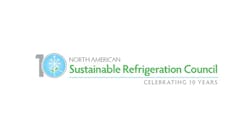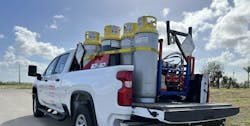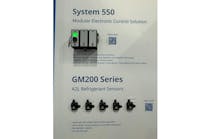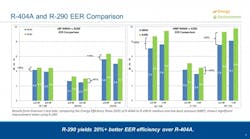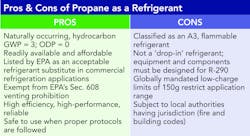In a time when refrigerants are being closely evaluated for their environmental impacts, propane (R-290) is emerging as an increasingly viable alternative. With a global warming potential (GWP) of 3 and an ozone depletion potential (ODP) of 0, R-290 poses virtually no threat to the environment. In fact, the Environmental Protection Agency (EPA) has listed R-290 as an acceptable refrigerant substitute under its Significant New Alternatives Policy (SNAP), and recently exempted it from the venting prohibition in Section 608 of the Clean Air Act.
CLICK HERE FOR A GRAPHIC COMPARISON OF R404A AND R290
For some perspective on what’s behind all the concern about refrigerants and the environment, the EPA estimates that an average supermarket using the hydrofluorocarbon (HFC) refrigerant R-404A leaks about 25 percent of its refrigerant charge annually, resulting in approximately 1,556 metric tons of carbon dioxide (CO2) equivalent emissions — or the annual energy from 165 homes. If you extrapolate that data across the number of grocery stores and other refrigeration applications in service globally, the magnitude of this impact quickly becomes apparent.
It’s no surprise then that an international wave of regulatory actions aimed at phasing down high-GWP HFC refrigerants is underway, including: the E.U.’s F-gas regulations, the EPA’s SNAP process and the recent amendment to the Montreal Protocol. One net result of this regulatory activity is an increased interest in the potential of natural refrigerants, including R-290.
With many operators stating corporate sustainability goals and seeking to avoid regulatory entanglements, R-290 is one of the few options capable of meeting both strategic objectives.
According to Howell Feig, national sales manager of AHT Cooling Systems USA, 2016 was a turning point for propane adoption.
“More and more of our customers are moving toward propane,” said Feig. “From a business perspective it just makes sense. Our self-contained, R-290 based units are eco-friendly, energy-efficient and reliable.” Changing perceptions lead to broader adoption
With many operators stating corporate sustainability goals and seeking to avoid regulatory entanglements, R-290 is one of the few options capable of meeting both strategic objectives. And, as modern refrigeration technology has evolved to ensure component and equipment safety, the stigma that R-290 is unsafe is quickly evaporating.
“It hasn’t been overnight, but perceptions about propane are definitely changing,” Feig said, recalling that AHT’s focus on propane started with its European customers almost 20 years ago.
By 2010, Feig said, some of AHT’s environmentally driven U.S. customers started asking for self-contained, R-290 based equipment. These early adopters served as a proof-of-concept for those who followed, including many of today’s retailers placing propane refrigeration applications in select stores.
When a major retailer like Target announces its plans to move toward R-290 based refrigeration systems, it’s an indication that viability and/or safety concerns are quickly becoming a thing of the past.
But when a major retailer like Target announces its plans to move toward R-290 based refrigeration systems, it’s an indication that viability and/or safety concerns are quickly becoming a thing of the past. Starting in 2016, the retailer stated that all of its new stand-alone coolers with a compressor capacity below 2,200 BTU/h would use propane.
Feig said that AHT is seeing a similar trend among its customer base, especially with retailers who have a strong commitment to sustainability across their entire food supply chain. Whole Foods is one such example.
“At this point, we’ve installed AHT propane cases in more than 100 Whole Foods stores across the country,” Feig said. He added that the retailer is known for evaluating every possible option to reduce its carbon footprint, and that AHT’s variety of propane-based equipment — from spot cases and islands to frozen doors and multi-deck units — constitutes a whole-store solution in many scenarios.
Another one of the chief concerns for moving to R-290 systems is the question of serviceability. Feig said that this is yet another lingering misperception.
“Our customers don’t have to deal with the complexity of remote refrigeration systems. Not only can technicians quickly be trained to work on these units; any problem they might have is isolated, meaning they don’t have to worry about food loss across a whole department,” he added.
Feig said AHT’s customers appreciate the simplicity of the installation process.
“Our cases are factory-sealed and extremely easy to deploy. Many of the models are plug and play, while others may require connection to a water loop. They are still relatively easy and quick to install,” he said. All of AHT’s current propane product line adheres to the R-290 charge limit of 150g.
R-290’s Future Potential
Recent regulatory activity has driven the commercial refrigeration industry to give R-290 another look. Although OEMs and operators alike are working within the 150g charge limit, Feig feels that even incremental increases would enable significant advances in system design and efficiencies.
“Increasing the charge limit would have a huge impact on case designs and further improve propane’s performance efficiencies,” said Feig. He explained that an increase to 500g (or even 1kg) would allow one compressor to service larger cases.
But even with the current 150g charge limit in place, Feig concluded that AHT will transition its entire product line to R-290 by the end of 2017



